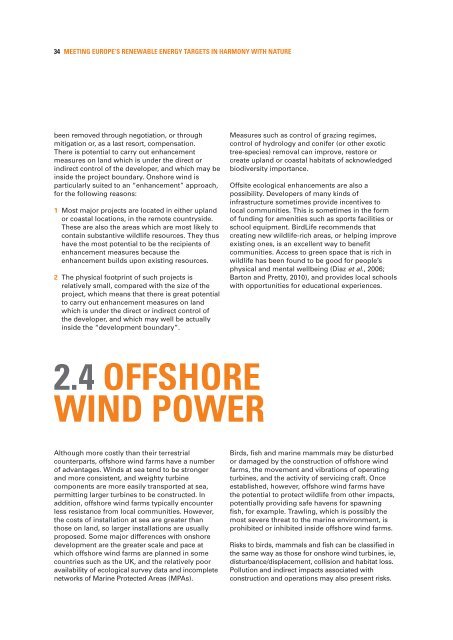Meeting Europe's renewable energy targets in harmony with - RSPB
Meeting Europe's renewable energy targets in harmony with - RSPB
Meeting Europe's renewable energy targets in harmony with - RSPB
Create successful ePaper yourself
Turn your PDF publications into a flip-book with our unique Google optimized e-Paper software.
34 MEETING EUROPE’S RENEWABLE ENERGY TARGETS IN HARMONY WITH NATURE<br />
been removed through negotiation, or through<br />
mitigation or, as a last resort, compensation.<br />
There is potential to carry out enhancement<br />
measures on land which is under the direct or<br />
<strong>in</strong>direct control of the developer, and which may be<br />
<strong>in</strong>side the project boundary. Onshore w<strong>in</strong>d is<br />
particularly suited to an “enhancement” approach,<br />
for the follow<strong>in</strong>g reasons:<br />
1 Most major projects are located <strong>in</strong> either upland<br />
or coastal locations, <strong>in</strong> the remote countryside.<br />
These are also the areas which are most likely to<br />
conta<strong>in</strong> substantive wildlife resources. They thus<br />
have the most potential to be the recipients of<br />
enhancement measures because the<br />
enhancement builds upon exist<strong>in</strong>g resources.<br />
2 The physical footpr<strong>in</strong>t of such projects is<br />
relatively small, compared <strong>with</strong> the size of the<br />
project, which means that there is great potential<br />
to carry out enhancement measures on land<br />
which is under the direct or <strong>in</strong>direct control of<br />
the developer, and which may well be actually<br />
<strong>in</strong>side the “development boundary”.<br />
Measures such as control of graz<strong>in</strong>g regimes,<br />
control of hydrology and conifer (or other exotic<br />
tree-species) removal can improve, restore or<br />
create upland or coastal habitats of acknowledged<br />
biodiversity importance.<br />
Offsite ecological enhancements are also a<br />
possibility. Developers of many k<strong>in</strong>ds of<br />
<strong>in</strong>frastructure sometimes provide <strong>in</strong>centives to<br />
local communities. This is sometimes <strong>in</strong> the form<br />
of fund<strong>in</strong>g for amenities such as sports facilities or<br />
school equipment. BirdLife recommends that<br />
creat<strong>in</strong>g new wildlife-rich areas, or help<strong>in</strong>g improve<br />
exist<strong>in</strong>g ones, is an excellent way to benefit<br />
communities. Access to green space that is rich <strong>in</strong><br />
wildlife has been found to be good for people’s<br />
physical and mental wellbe<strong>in</strong>g (Diaz et al., 2006;<br />
Barton and Pretty, 2010), and provides local schools<br />
<strong>with</strong> opportunities for educational experiences.<br />
2.4 OFFSHORE<br />
WIND POWER<br />
Although more costly than their terrestrial<br />
counterparts, offshore w<strong>in</strong>d farms have a number<br />
of advantages. W<strong>in</strong>ds at sea tend to be stronger<br />
and more consistent, and weighty turb<strong>in</strong>e<br />
components are more easily transported at sea,<br />
permitt<strong>in</strong>g larger turb<strong>in</strong>es to be constructed. In<br />
addition, offshore w<strong>in</strong>d farms typically encounter<br />
less resistance from local communities. However,<br />
the costs of <strong>in</strong>stallation at sea are greater than<br />
those on land, so larger <strong>in</strong>stallations are usually<br />
proposed. Some major differences <strong>with</strong> onshore<br />
development are the greater scale and pace at<br />
which offshore w<strong>in</strong>d farms are planned <strong>in</strong> some<br />
countries such as the UK, and the relatively poor<br />
availability of ecological survey data and <strong>in</strong>complete<br />
networks of Mar<strong>in</strong>e Protected Areas (MPAs).<br />
Birds, fish and mar<strong>in</strong>e mammals may be disturbed<br />
or damaged by the construction of offshore w<strong>in</strong>d<br />
farms, the movement and vibrations of operat<strong>in</strong>g<br />
turb<strong>in</strong>es, and the activity of servic<strong>in</strong>g craft. Once<br />
established, however, offshore w<strong>in</strong>d farms have<br />
the potential to protect wildlife from other impacts,<br />
potentially provid<strong>in</strong>g safe havens for spawn<strong>in</strong>g<br />
fish, for example. Trawl<strong>in</strong>g, which is possibly the<br />
most severe threat to the mar<strong>in</strong>e environment, is<br />
prohibited or <strong>in</strong>hibited <strong>in</strong>side offshore w<strong>in</strong>d farms.<br />
Risks to birds, mammals and fish can be classified <strong>in</strong><br />
the same way as those for onshore w<strong>in</strong>d turb<strong>in</strong>es, ie,<br />
disturbance/displacement, collision and habitat loss.<br />
Pollution and <strong>in</strong>direct impacts associated <strong>with</strong><br />
construction and operations may also present risks.
















